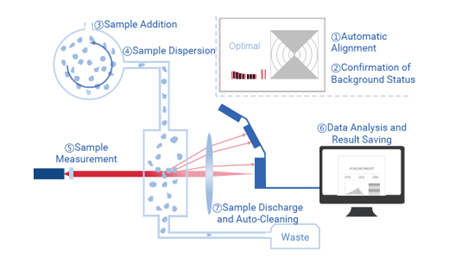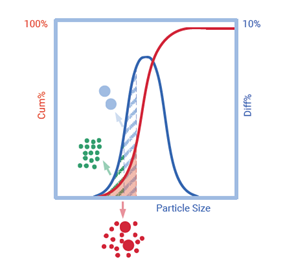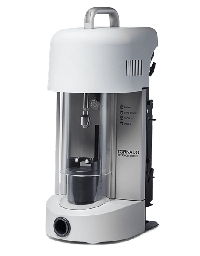Understanding particle size distribution is crucial as it directly affects product performance and quality. Laser diffraction is the most widely used technology and enables precise measurement of particle size, allowing you to optimize formulations, enhance process efficiency, and ensure consistent product characteristics. Dive deep into the details of particle size with our cutting-edge instruments from Beckman Coulter and Bettersize.
What is Particle Size and Particle Size Distribution?
A particle's size is commonly expressed in terms of millimeters, micrometers, or nanometers. The most used parameter to describe particle size is particle diameter. The particle size distribution describes how particle sizes are distributed in a particle population, such as a bag of flour or a pile of sand. Particle size distribution is expressed as the percentage of particles of a specific size or within a certain size range. Both particle size and distribution are primary parameters to characterize particles. Laser diffraction is the most widely used method for measuring particle size distribution, yielding a distribution based on the volume percentage of particles, i.e., volume distribution.
How is a measurement made with a laser diffraction particle size analyzer?

Laser diffraction is a particle sizing technique that relies on the fundamental principle of light scattering. In this method, a monochromatic laser beam is directed onto a sample containing particles, whether they are suspended in a liquid or present in a powder. When the laser light interacts with these particles, it scatters in multiple directions (diffraction or scattering patterns). These patterns contain valuable information about the sizes and distribution of particles within the sample. Detectors strategically positioned around the sample collect the scattered light, measuring both the angles and intensities of the scattered beams.
Advanced mathematical algorithms, such as Mie theory or Fraunhofer diffraction theory, are then applied to interpret the scattering data. These algorithms take into account various factors, including the laser's properties, the refractive index of the particles, and the scattering angles. Through this mathematical analysis, the instrument generates a detailed particle size distribution profile, often presented as a histogram or cumulative distribution curve.
The resulting particle size distribution graph provides insights into the abundance of particles within different size ranges in the sample. This information is invaluable across numerous industries, such as pharmaceuticals, materials science, environmental monitoring, and manufacturing. It aids in optimizing formulations, ensuring product quality, and advancing research and development efforts.
In summary, laser diffraction is a powerful analytical tool that delivers comprehensive insights into particle size distributions, making it invaluable across numerous industries for quality control, research, and process optimization. Its ability to provide rapid, precise, and non-destructive measurements has established it as a cornerstone of particle characterization.
As a trusted distributor of Beckman Coulter and Bettersize, we are thrilled to introduce you to a range of laser diffraction instruments that can elevate your processes across various industries.

LS 13 320 XR
Laser Diffraction Particle Size Analyzer
The LS 13 320 XR offers particle size distribution data from advanced PIDS technology, which enables high-resolution measurements and an expanded dynamic range. The LS 13 320 XR particle size analyzer provides fast, accurate results, and helps you streamline workflows to optimize efficiency.
Bettersizer S3 Plus
Laser Diffraction Particle Size and Shape Analyzer
The Bettersizer S3 Plus combines laser diffraction and dynamic image analysis in one instrument. It can measure the size and shape of particles from 0.01 μm to 3500 μm. Its exceptional sensitivity for either ultrafine particles or oversized particles, and unsurpassed resolution, make it a powerful size and shape analyzer.
Bettersizer 2600
Laser Diffraction Particle Size Analyzer
Particle size can be measured by either wet or dry method, using the Bettersizer 2600. A variety of applications have been covered by this versatile, powerful analyzer with its modular design and patented technologies. Users can characterize materials from 0.02 μm to 2600 μm, easily and accurately.
Our products

The dry powder system module delivers reliable results from 400 nm - 3500 µm for all types of homogeneous and heterogeneous samples that can be dispersed dry.
Analytical size range: 400 nm - 3500 µm
- Measures entire sample as required by the ISO 13 320 Standard
- Programmable Obscuration setting to optimize sample feed rate
- User-selectable vacuum pressure for maximum dispersion control

The LS 13 320 XR laser diffraction particle sizing analyzer offers best-in-class particle size distribution data from advanced PIDS technology, which enables high-resolution measurements and an expanded dynamic range. Like the LS 13 320, the XR particle size analyzer provides fast, accurate results, and helps you streamline workflows to optimize efficiency. Some big improvements help you reliably spot small differences that can have a huge impact on your particle analysis data.
- Direct measurement range from 10 nm – 3500 µm
- Automatically highlights pass/fail results for faster quality control
- Enhanced software that simplifies method creation for standardized measurements
- New control standards to adequately verify instrument/module performance











